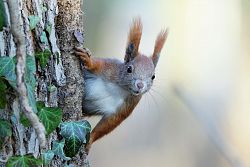

A monitoring programme carried out by Red Squirrels Northern England (RSNE) in 2024 has highlighted a rise in both red and grey squirrels.
246 surveys were collected across Northern England and showed that occupancy figures for red and grey squirrels are increasing, but increases for grey squirrels were steeper. The RSNE group said red squirrels were found in 52% of sites this year, up from 50% in 2023. Grey squirrels were found in 69% of sites, up from 62% in 2023.
Although the survey shows that conservation efforts for red squirrels have been successful, RSNE said the "substantial" increase in grey presence was concerning.
RSNE have been conducting research since 2012 including surveying 3245 woodlands and gardens. The research for 2024 involved 180 people, 74% of surveys delivered by volunteers and 26% delivered by staff.
Abbie McQueen, RSNE's project officer, commented: "The substantial increase in grey squirrel presence once again this year is concerning, however we are not disheartened and hope it can help build a case for further funding and support for red squirrels in areas that need it."
"We can also confirm that red squirrel detection is remaining stable, indicating that they are retaining their range and all the conservation effort is successfully protecting our populations."
Others such as Ian Glendinning, the chair of the Northumberland branch of Northern Red Squirrels are more concerned about the growing number of grey squirrels as any increase can lead to uncontrolled breeding, with grey squirrels becoming saturated and moving outwards. He said:
"I do feel we are fighting a losing battle, albeit slowly. There are glimmers of light on the horizon with chemical interventions. But they are many years in the future and my fear is that, certainly in England and Wales, we will see local extinction before they come into being."